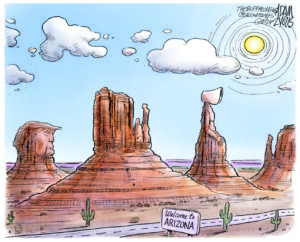Immigrant Protections Eroded After Trump Took Office
Since then, the administration has issued at least half a dozen changes affecting immigrant children, many of them obscure revisions. The cumulative effect is a dramatic alteration of immigration policy and practice.The Trump administration’s move to separate immigrant parents from their children on the U.S.-Mexico border has grabbed attention around the world, drawn scorn from human-rights organizations and overtaken the immigration debate in Congress.
It’s also a situation that has been brewing since the week President Donald Trump took office, when he issued his first order signaling a tougher approach to asylum-seekers. Since then, the administration has been steadily eroding protections for immigrant children and families.
“They’re willing to risk harm to a child being traumatized, separated from a parent and sitting in federal detention by themselves, in order to reach a larger policy goal of deterrence,” said Jennifer Podkul, director of policy at Kids in Need of Defense, which represents children in immigration court.
To those who work with immigrants, the parents’ plight was heralded by a series of measures making it harder for kids arriving on the border to get released from government custody and to seek legal status here.
The administration says the changes are necessary to deter immigrants from coming here illegally. But a backlash is mounting, fueled by reports of children being taken from mothers and distraught toddlers and elementary school age children asking, through tears, when they can see their parents.
About 2,000 children had been separated from their families over a six-week period ending in May, administration officials said Friday.
Among the parents caught up in the new rules is 29-year-old Vilma Aracely Lopez Juc de Coc, who fled her home in a remote Guatemalan village after her husband was beaten to death in February, according to advocates. When she reached the Texas border with her 11-year-old son in May, he was taken from her by border agents, she said.
Her eyes swollen, she cried when she asked a paralegal what she most wanted to know: When could she see her son again?
“She did not know what was going on,” said paralegal Georgina Guzman, recalling their conversation at a federal courthouse in McAllen, Texas.
Similar scenarios play out on a daily basis in federal courtrooms in Texas and Arizona, where dozens of immigrant parents appear on charges of entering the country illegally after traveling up from Central America. More than the legal outcome of their cases, their advocates say, they’re worried about their children.
Since Trump’s inauguration, the administration has issued at least half a dozen orders and changes affecting immigrant children, many of them obscure revisions. The cumulative effect is a dramatic alteration of immigration policy and practice.
The measures require a senior government official to sign off on the release of children from secure shelters and allow immigration enforcement agents access to information about sponsors who sign up to take the children out of government custody and care for them.
The crackdown expanded in April, when the administration announced a “zero tolerance” policy on the border to prosecute immigrants for entering the country illegally in the hopes they could be quickly deported and that the swift deportations would prevent more people from coming.
Parents are now being arrested and placed in quick federal court proceedings near the border. Since children cannot be jailed in federal prisons, they’re placed in shelters that have long existed for unaccompanied immigrant children arriving on the border alone.
The administration insists the new rules are necessary to send a message to immigrants.
“Look, I hope that we don’t have to separate any more children from any more adults,” Attorney General Jeff Sessions said last week. “But there’s only one way to ensure that is the case: It’s for people to stop smuggling children illegally. Stop crossing the border illegally with your children. Apply to enter lawfully. Wait your turn.”
Immigration on the southwest border has remained high since the zero-tolerance policies took effect. Border agents made more than 50,000 arrests in May, up slightly from a month earlier and more than twice the number in May 2017. About a quarter of arrests were families traveling with children.
In addition to those trying to cross on their own, large crowds of immigrants are gathered at border crossings each day to seek asylum. Some wait days or weeks for a chance to speak with U.S. authorities. On a Texas border bridge, parents and children have been sleeping in sweltering heat for several days awaiting their turn.
Under U.S. law, most Mexican children are sent back across the border. Central American and other minors are taken into government custody before they are mostly released to sponsors in the United States.
The arrival of children fleeing violence in Central America is not new. President Barack Obama faced an even larger surge in border crossings that overflowed shelters and prompted the authorities to release many families. Nearly 60,000 children were placed in government-contracted shelters in the 2014 fiscal year.
Obama administration lawyers argued in federal court in Los Angeles against the separation of parents and children and in favor of keeping in family detention facilities those deemed ineligible for release.
Immigrant and children’s advocates said the new measures are not only cruel but costly. They argued that children fleeing violence and persecution in El Salvador, Guatemala and Honduras will continue to come to the United States and remain in government custody longer, costing taxpayers more money.
The government pays more than $1 billion a year to care for unaccompanied immigrant children, Sessions has said.
In May 2014, the average length of stay for children in custody was 35 days. So far this fiscal year, it’s taking 56 days for children to be released to sponsors — in most cases, their own relatives.
Many children were released to sponsors who did not have legal immigration status. That’s yet another concern child advocates now have since the Trump administration is requiring fingerprints of sponsors and their household members and will turn that data over to the immigration agency in charge of deportations.
Advocates say the new information sharing might lead some parents to shy away from sponsoring their own children and ask others to do so, a situation that can lead to cases of trafficking or neglect.
Simon Sandoval-Moshenberg, legal director of the immigrant advocacy program at the Legal Aid Justice Center in Virginia, said he’s never worked with immigrants who said U.S. policies influenced their decision to move. They are fleeing violence and persecution, and he doesn’t see that changing even if the government deports parents.
“Look six months out from now,” he said. “Are these moms going to stay in Guatemala? Hell no, they’re going to come back looking for their kids.”
Your support matters…Independent journalism is under threat and overshadowed by heavily funded mainstream media.
You can help level the playing field. Become a member.
Your tax-deductible contribution keeps us digging beneath the headlines to give you thought-provoking, investigative reporting and analysis that unearths what's really happening- without compromise.
Give today to support our courageous, independent journalists.






You need to be a supporter to comment.
There are currently no responses to this article.
Be the first to respond.